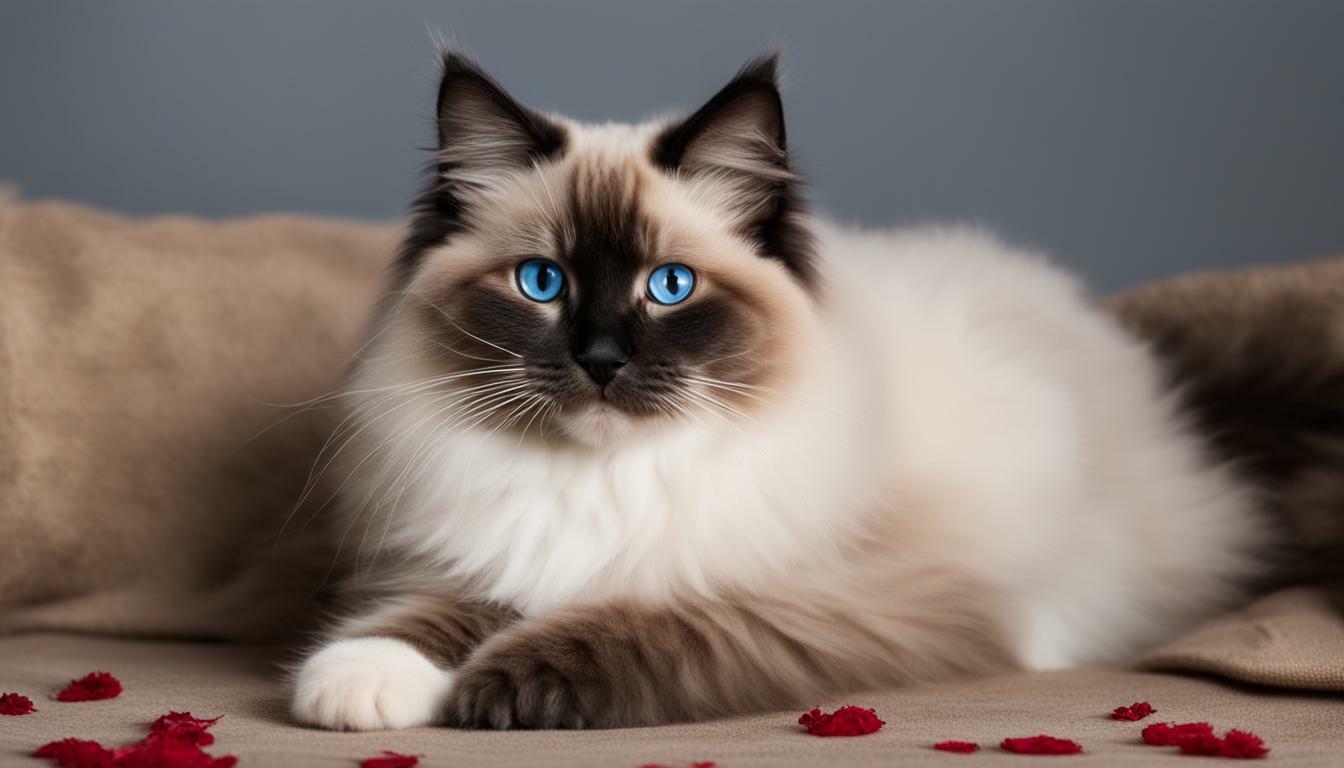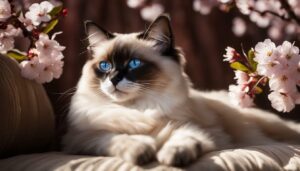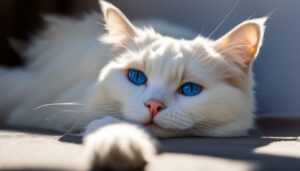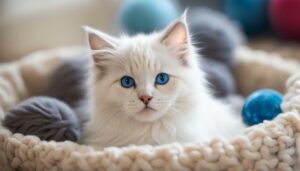Ragdoll cats are known for their variety of types, which include different breeds, colors, and patterns. These beautiful feline companions come in a wide array of colors, including Seal, Blue, Chocolate, Lilac, Flame, Cream, White, and Black. Each color has its own unique beauty and charm, adding to the allure of these amazing cats.
In addition to their stunning colors, ragdoll cats also boast a range of coat patterns. The Point pattern is characterized by darker points on the ears, face, paws, and tail, creating an elegant contrast. The Mitted pattern, on the other hand, features adorable white “mittens” on the paws, adding a touch of charm to their adorable appearance.
Bicolor Ragdolls have a distinctive inverted ‘V’ shape on their face and exhibit white legs and belly, making them truly eye-catching. For those who appreciate a touch of wild beauty, Lynx Ragdolls possess a tabby-like pattern with stripes on their face, legs, and tail. Tortie Ragdolls, on the other hand, feature a captivating mix of colors in a tortoiseshell pattern, while Torbie Ragdolls combine the beauty of Tortie and Lynx patterns, resulting in a truly unique and mesmerizing coat.
Key Takeaways:
- Ragdoll cats come in a variety of colors, including Seal, Blue, Chocolate, Lilac, Flame, Cream, White, and Black.
- They also have different coat patterns such as Point, Mitted, Bicolor, Lynx, Tortie, and Torbie.
- The Point pattern features darker points on the ears, face, paws, and tail.
- The Mitted pattern showcases cute white “mittens” on the paws.
- Bicolor Ragdolls have a white inverted ‘V’ on the face and white legs and belly.
Ragdoll Cat Breeds
Within the ragdoll cat breed, there are several distinct breeds, each with its own set of characteristics and size variations. Let’s take a closer look at some of the most popular ragdoll cat breeds:
Traditional Ragdoll
The traditional ragdoll cat breed is the most well-known. These cats are large in size, with males weighing between 15-20 pounds and females weighing around 10-15 pounds. They have a semi-long coat that comes in a variety of colors and patterns, and their striking blue eyes are one of their most defining features. Traditional ragdolls are known for their calm and gentle temperament, making them perfect companions for families.
Mink Ragdoll
The mink ragdoll is a relatively newer breed that features a denser and silkier coat than the traditional ragdoll. They have deeper and richer color points, and their eye color ranges from blue-green to aqua. Mink ragdolls have a similar temperament to traditional ragdolls, although they are known to be slightly more active and playful.
Sepia Ragdoll
The sepia ragdoll is the darkest of the ragdoll cat breeds. They have intense color points and striking gold or green eyes. Sepia ragdolls are known for their affectionate and calm nature, making them great companions. They are also more robust and muscular compared to other ragdoll breeds.
| Ragdoll Cat Breed | Size | Coat Characteristics | Temperament |
|---|---|---|---|
| Traditional Ragdoll | Males: 15-20 pounds Females: 10-15 pounds |
Semi-long coat in various colors and patterns | Gentle and calm |
| Mink Ragdoll | Males: 15-20 pounds Females: 10-15 pounds |
Denser and silkier coat with richer color points | Playful and affectionate |
| Sepia Ragdoll | Males: 15-20 pounds Females: 10-15 pounds |
Intense color points | Affectionate and calm |
Whether you prefer the traditional, mink, or sepia ragdoll, each breed offers its own unique characteristics and qualities. Consider your lifestyle and preferences when choosing a ragdoll cat breed, and you’ll find the perfect feline companion to bring joy and beauty into your life.
Ragdoll Cat Colors and Patterns
Ragdoll cats exhibit a stunning array of colors and patterns, with each shade and design adding to their unique beauty. The main colors found in ragdolls include Seal, Blue, Chocolate, Lilac, Flame, Cream, White, and Black. Each color has its own distinct characteristics and can vary in depth and intensity.
In addition to their rich colors, ragdolls come in various coat patterns that further enhance their appeal. The Point pattern is one of the most well-known, featuring darker points on the ears, face, paws, and tail, creating a striking contrast against the lighter body color. The Mitted pattern is characterized by white “mittens” on the front paws, as well as white on the hind legs and chest. It gives the appearance of wearing gloves, adding a touch of elegance to the cat’s overall look.
Another pattern seen in ragdolls is Bicolor. Bicolor Ragdolls have a white inverted ‘V’ on the face, which is known as a “blaze,” and white legs and belly. This pattern creates a charming and distinctive facial marking. The Lynx pattern, also referred to as Tabby, displays stripes on the face, legs, and tail, giving the cat a wild and beautiful appearance. The Tortie pattern consists of a mix of colors in a tortoiseshell pattern, which can produce a stunning array of rich hues blending together. Lastly, the Torbie pattern is a combination of Tortie and Lynx patterns, resulting in a cat with captivating colors and intricate patterns.
| Color | Pattern |
|---|---|
| Seal | Point |
| Blue | Point |
| Chocolate | Point |
| Lilac | Point |
| Flame | Point |
| Cream | Point |
| White | Point, Mitted, Bicolor, Lynx, Tortie, Torbie |
| Black | Point, Mitted, Bicolor, Lynx, Tortie, Torbie |
These various colors and patterns contribute to the allure of ragdoll cats, making them a popular choice among cat enthusiasts. Whether you prefer the elegance of the Point pattern, the charm of the Mitted pattern, or the unique blend of colors in the Tortie and Torbie patterns, there is a ragdoll cat to suit every taste and preference.
Ragdoll Cat Temperament and Personality
Ragdoll cats are renowned for their gentle and friendly temperament, making them perfect companions for families and individuals alike. These cats are known to be loving, affectionate, and social, and they form strong bonds with their owners. They have a calm and relaxed nature, often described as “floppy” due to their tendency to go limp when picked up, hence the name “ragdoll”.
One of the defining characteristics of ragdolls is their docile nature, which makes them suitable for households with children and other pets. They are patient and tolerant, rarely displaying aggression or hostility. Ragdolls enjoy being part of the family and are known to follow their owners around the house, often seeking attention and companionship.
In addition to their gentle temperament, ragdolls are also known for their intelligence and adaptability. They are quick to learn and can be easily trained to perform tricks or use a litter box. Their laid-back nature allows them to adjust well to different environments, making them well-suited for apartment living or households with busy lifestyles.
When it comes to personality, ragdolls are often described as “dog-like” due to their loyalty and willingness to interact with their owners. They are known to play fetch, greet their owners at the door, and even enjoy going for walks on a leash. Their sociable and friendly nature makes them a joy to have as a pet, providing companionship and entertainment for their owners.
| Temperament | Personality |
|---|---|
| Gentle | Loving |
| Friendly | Affectionate |
| Social | Loyal |
| Docile | Intelligent |
| Tolerant | Adaptable |
“Ragdolls are like cuddly teddy bears. They have the sweetest temperament and always want to be near you.” – Ragdoll owner
Caring for Ragdoll Cats
To ensure the health and happiness of a ragdoll cat, proper care and attention are essential in areas such as grooming, nutrition, exercise, and overall well-being. These beautiful feline companions have specific needs that should be met to keep them in optimal condition.
Grooming: Ragdolls have semi-long fur that requires regular brushing to prevent matting and to remove loose hair. Aim to brush their coat at least once a week and increase the frequency during shedding seasons. Additionally, pay attention to their eyes and ears, keeping them clean and free from any discharge or debris.
Nutrition: Providing a balanced and nutritious diet is fundamental for the well-being of your ragdoll cat. Choose high-quality cat food that meets their nutritional requirements. Consult with your veterinarian to determine the appropriate portion sizes and feeding schedule for your feline friend.
Exercise: While ragdoll cats are known for their laid-back nature, they still require regular exercise to stay healthy and prevent obesity. Engage in interactive play sessions with toys that encourage physical activity and mental stimulation. Set aside time each day to play and interact with your ragdoll to keep them active and engaged.
| Grooming | Nutrition | Exercise |
|---|---|---|
| Regular brushing to prevent matting and remove loose hair | Provide a balanced and nutritious diet | Engage in interactive play sessions |
| Keep eyes and ears clean | Consult with a veterinarian for portion sizes and feeding schedule | Set aside time for daily play and interaction |
Overall Well-being: Ensuring the overall well-being of your ragdoll cat involves providing a safe and comfortable environment, regular veterinary check-ups, and proper hygiene. Maintain a clean litter box, provide them with a cozy bed, and create spaces for them to relax and retreat. Regularly monitor their health and behavior, and seek veterinary care as needed to address any concerns.
By giving your ragdoll cat the care and attention they need, you can enjoy a fulfilling and loving relationship with your furry friend for years to come. Remember to always prioritize their well-being and seek professional guidance when necessary to provide them with the best possible care.
Conclusion
In conclusion, ragdoll cats captivate us with their wide range of types, each possessing its own distinct characteristics and qualities that make them truly special companions.
One of the most fascinating aspects of ragdoll cats is their variety of colors, which include Seal, Blue, Chocolate, Lilac, Flame, Cream, White, and Black. Each color has its own unique beauty and charm, allowing owners to choose a ragdoll cat that matches their personal preferences.
Moreover, ragdolls also exhibit different coat patterns. The Point pattern features darker points on the ears, face, paws, and tail, creating a striking contrast. The Mitted pattern, on the other hand, sports adorable white “mittens” on the paws, adding a touch of elegance to their appearance.
For those looking for a more distinctive look, Bicolor Ragdolls have a white inverted ‘V’ on the face and white legs and belly. Lynx Ragdolls feature a tabby-like pattern with stripes on the face, legs, and tail, giving them a wild and adventurous look. Additionally, Tortie Ragdolls display a beautiful mix of colors in a tortoiseshell pattern, while Torbie Ragdolls combine Tortie and Lynx patterns, resulting in a truly unique and eye-catching appearance.
FAQ
Q: What are the different types of ragdoll cats?
A: Ragdoll cats come in a wide variety of colors and patterns, including Seal, Blue, Chocolate, Lilac, Flame, Cream, White, and Black.
Q: What are the different coat patterns of ragdoll cats?
A: Ragdolls have different coat patterns, such as Point, Mitted, Bicolor, Lynx, Tortie, and Torbie. The Point pattern features darker points on the ears, face, paws, and tail. The Mitted pattern has white “mittens” on the paws. Bicolor Ragdolls have a white inverted ‘V’ on the face and white legs and belly. Lynx Ragdolls have a tabby-like pattern with stripes on the face, legs, and tail. Tortie Ragdolls have a mix of colors in a tortoiseshell pattern, while Torbie Ragdolls combine Tortie and Lynx patterns.
Q: What are the temperament and personality traits of ragdoll cats?
A: Ragdoll cats are known for their gentle and affectionate nature. They are typically social and relaxed, making them great companions for families and individuals alike.
Q: How should I care for my ragdoll cat?
A: Proper care for ragdoll cats includes regular grooming, providing a balanced diet, ensuring they get enough exercise, and scheduling routine vet visits to maintain their overall health and well-being.



